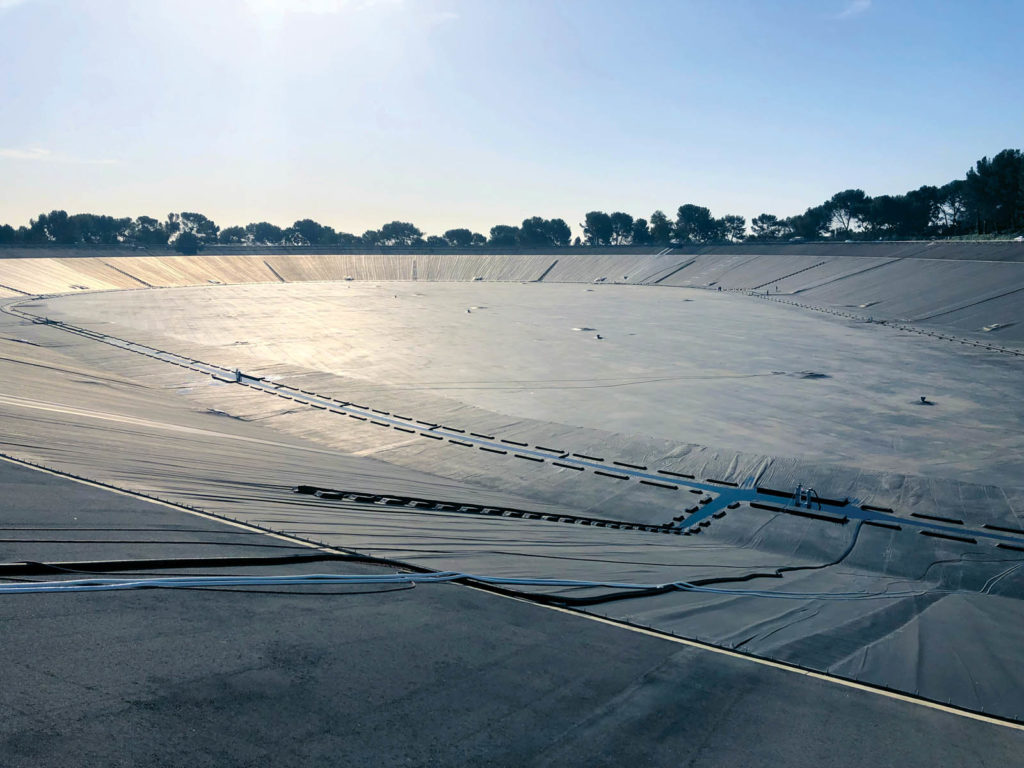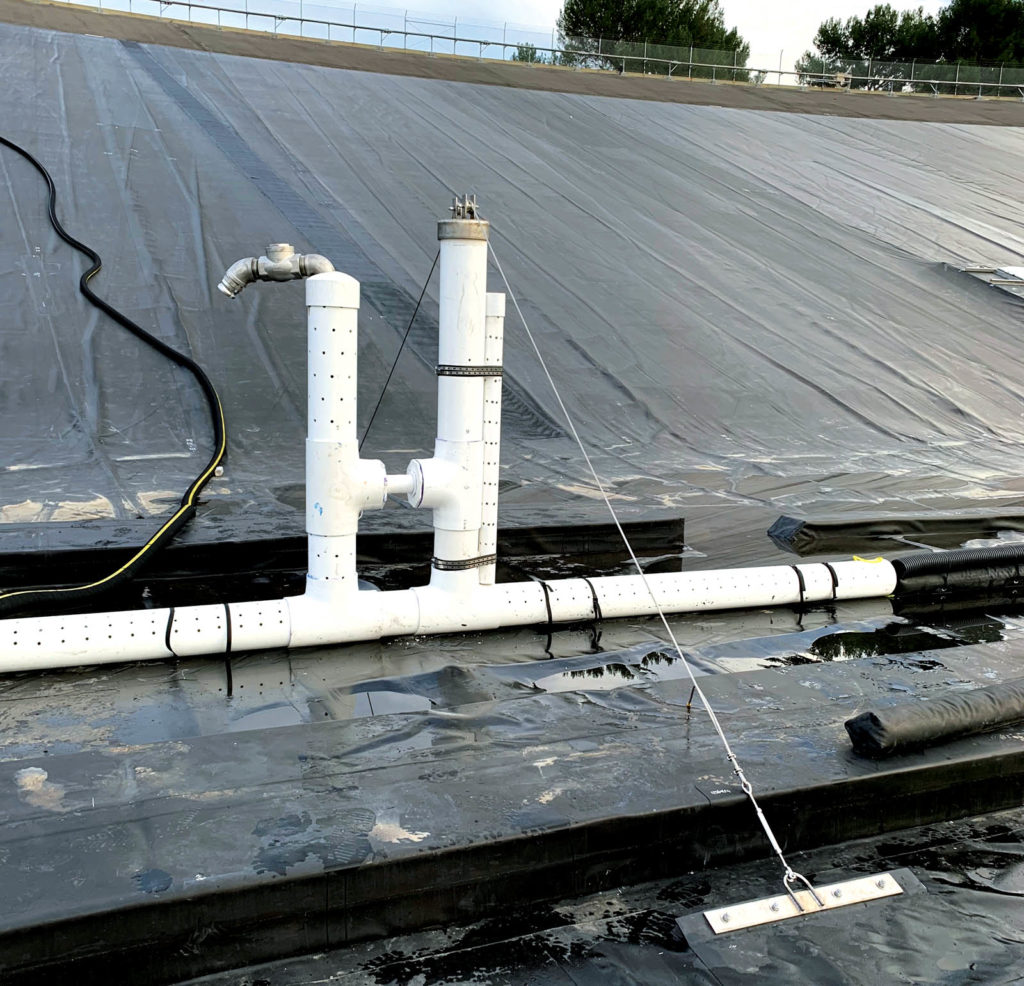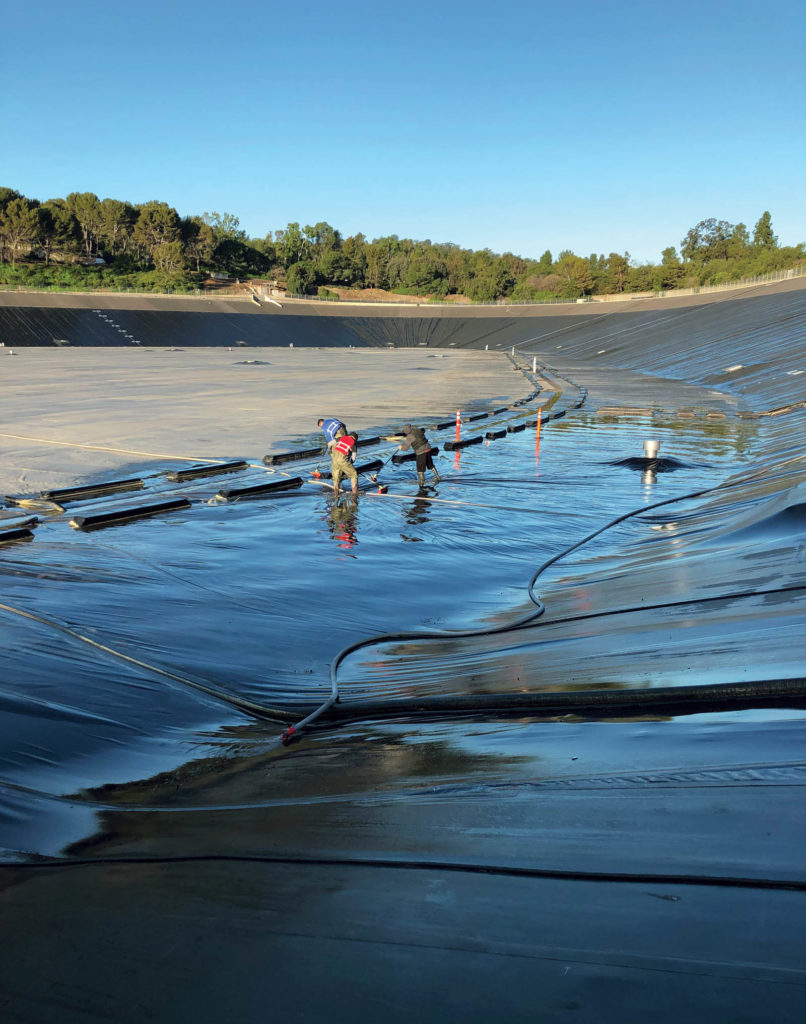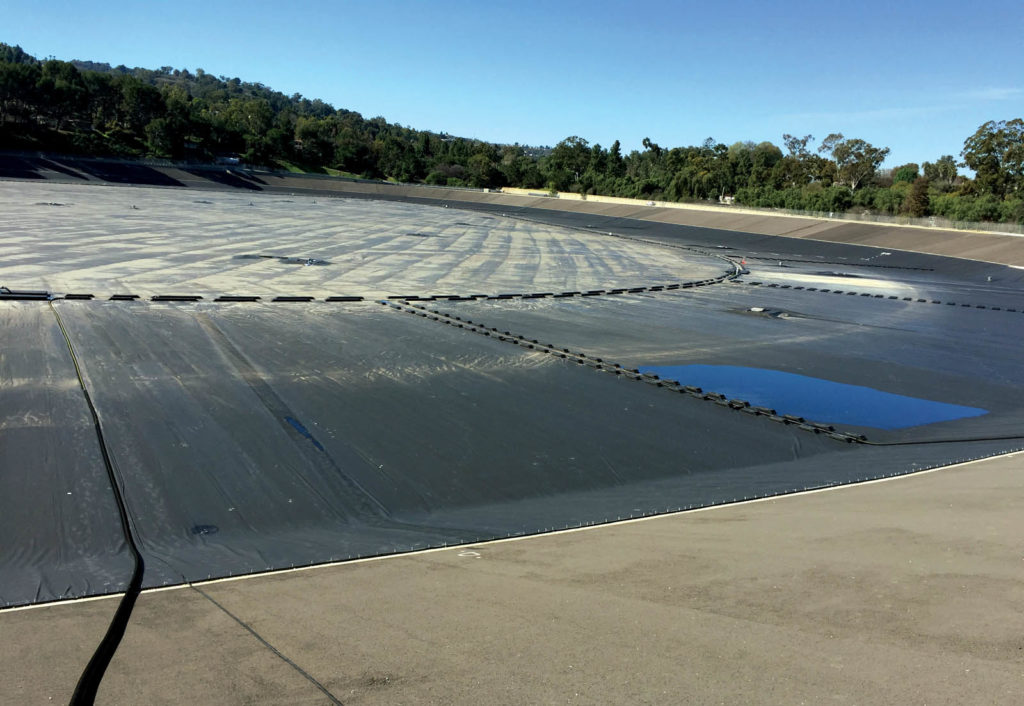By John Heap and Chris Kelsey
The active site work for the Palos Verdes Reservoir’s substantial update began in late 2016, advanced primarily throughout 2018 and concluded in the second quarter of 2019 with the filling of the reservoir. The project was immense for everyone involved, and with that has come the expected excitement, challenges and revisions. Though weather and site soils do not always cooperate, as this project proves, hard work, a strong focus on communication and effective planning can overcome most of the challenges presented by sites with a large footprint and complex structures.
Project and series background
The Palos Verdes Reservoir in Los Angeles County boasts an impressive service life. The original construction was completed in 1939. Over the years, the site has played an important role in the Metropolitan Water District (MWD) of Southern California’s potable water network.
The avocado-shaped cell, with its 83-foot (25.3-m) tall dam and a crest length of 2,150 feet (655.3 m), was identified as having plenty of life left in it; but, to achieve a significant service life extension—essentially giving the facility a new life—substantial reconditioning was required to bring it on level with the engineering and performance strategies used at the county’s newer facilities. Major changes to the reservoir included revitalizing the subgrade, reducing the operating volume from 1,000 to 614 acre-feet (326 million gallons [1.2 billion liters] to 200 million gallons [757 million liters]), and installing new geosynthetic lining and floating cover systems (Figure 1).

In Part 1 of this article series, we described the site parameters, design concerns, and how geosynthetic manufacturing and fabrication planning were utilized to keep the project moving toward its objectives.
Part 2 documented the full fabrication stage, site staging of materials and installation planning for a more rapid execution in the wake of a site subgrade preparation delay.
Part 3 focused on the facility as it neared recommissioning of its full operation.
Here, in Part 4, we advance into the initial filling, disinfection and operational start-up. Everything involved in this late phase is connected to the lining and cover systems, particularly with respect to what should be done in order to keep the floating cover system operating at optimal level.
Initial fill at Palos Verdes
The MWD is one of the largest water districts in the world and is responsible for the Palos Verdes Reservoir. In February, with the 60-mil (1.5-mm) chlorosulfonated polyethylene (CSPE) geosynthetic liner, 45-mil (1.1-mm) CSPE floating cover system and affiliated structural components installed, MWD opened the gates and filled the reservoir over a five-day window.
Although this fill involved the full 200 million gallons the site has been redesigned to operate with, it was not the final fill. This phase was designed to manage the disinfection of the reservoir to prepare for filling with finished potable water.
When filling the reservoir, the water must be carefully released and closely monitored. The water level must be brought up slowly, particularly early on, so the lining system and floating cover, hatches and mechanical systems are not overstressed. The geosynthetic cover must be monitored for how it rises. Personnel must watch carefully to ensure nothing catches during this rise and that the large polyvinyl chloride (PVC) pump housing system (Figure 2), set in the middle of the rainwater collection trough (RCT), is kept stable by the weight and cable system as they sink in during the fill stage.

Once the water has covered the bottom section and all inlets are fully submerged—a critical elevation level—the base lining and floating cover systems have typically reached the stabilization point. Filling may then advance to full speed.
A chlorine component was utilized during the first fill at Palos Verdes to disinfect the lining and floating cover systems. The reservoir was then left full for a designated period to accomplish the disinfection while site personnel tested the cover, hatches, rain troughs, vents and pump systems. These tests were used to verify that, with the facility full, all components were functioning to the project’s design standards.
The project punch list
As the disinfection and testing phase wrapped up, MWD prepared its punch list of any open items left to address. The punch list is an essential standard closing aspect of work like this, as it stands for a lot more than just the final steps. Everyone involved must keep in view the critical nature of delivering a safe, finished water supply to constituents’ taps and all the steps that must be taken to keep a large facility operating in accordance with state and federal requirements.
The punch list provides a great opportunity for everyone to view the complexity of the work that’s been conducted. The review can provide inspiration for finding new efficiencies, cost savings, or design and construction approaches for future designs.
MWD gathered all relevant project partners to assess the site and its systems, review tests and confirm the strategies used to finish up any remaining items.
For Palos Verdes, no substantial work was left, but as with other sites in Southern California’s water infrastructure, there was an emphasis on ensuring that the site met the stringent requirements of California’s Department of Water Resources and its Division of Safety and Dams. The on-site operations and maintenance program, overseen by MWD, monitors all activities inside the fence of water storage reservoirs. This includes not only the systems focused on in this article series, but also access control, rodent control, erosion control and general site maintenance. They are all part of the operations and maintenance effort. A written plan is to be followed by MWD employees and all outside contractors.
When these various aspects were addressed, Raven CLI Construction (which fabricated and installed the geosynthetic lining and floating cover systems) performed its final work: re-inspection and cleaning.
A clean finish
The extra cleaning and inspection stage helped evaluate how the full cover performed during the disinfection fill. While the filling operation helped the team observe the rise of the cover, this additional inspection enabled the crew to test components as they carefully reversed the process.
As the reservoir water level was lowered, the rainwater troughs were flushed out. Piece by piece, the 14 hatches were inspected, as were the numerous pumps, vents and attachments. The process took a six-person crew five days to complete (Figure 3). All water used for washing down and cleaning out debris was supplied from hoses attached to the fire hydrants at the top of slope.

collection troughs in the clean-out phase
The typical potable water floating cover maintenance plan involves an annual cleaning of the full floating cover. Rainwater collection troughs are generally cleaned twice a year. With the troughs, extra attention should be paid to remove leaves, twigs, rocks and other foreign objects. This is critical to keep the floating cover from being damaged and reduces wear and tear on the system while providing a good visual check of all systems.
The authors recommend that this type of floating cover cleaning schedule be part of all reservoir cover operations and maintenance plans. It helps keep the floating cover in good operating condition and gives the system installer and the site owners extremely useful information on how the system is aging. The Palos Verdes site is a great example of how regular inspection supports long-term performance. The facility has reached its current age through the support of a strong operations and maintenance program, along with operators who have routinely taken the long view on what next steps are needed to protect water quality and ensure longevity (Figure 4).

Regarding the geosynthetic system now installed at Palos Verdes, the type of CSPE geomembrane used for the lining and floating cover has a strong project record at potable water storage sites throughout California. The record includes multiple sites with 25 plus years of performance. Proper maintenance of the cover and troughs goes a long way toward achieving service life like this.
Similarly, regular inspection of the mechanical systems is recommended to identify any patterns of wear or damage that have occurred. If each piece of the system is looked after, the full site will perform better. MWD, for example, utilizes an internal team of certified commercial divers to inspect the undersides of covers annually. The agency also has an internal cover cleaning crew that follows the bi-annual cover-cleaning recommendations.
Raven CLI Construction completed its full floating cover cleaning in April 2019. An additional inspection and review will be conducted immediately prior to 24 months of operation on the site. At that point, the team will walk the entire floating cover and liner; inspect hatches, vents, floats and rain troughs; and all in all, assess the CSPE material for any issues that may have developed in the early years of operation.
Acknowledgments
When “Reviving the Palos Verdes Reservoir” was originally proposed as an article series, the idea was fairly simple: a three-part series to document three key phases of a large project: planning, installation and commissioning. We wanted to show a project in near-real time, working with the Geosynthetics editor to deliver updates as near to when the work was conducted as was possible. We also saw the series as a way to deliver a few more of the “dirty boots” details of a complex project. As we ventured into it, however, we experienced a project delay and, thus, had additional site details we wanted to share. At least one more installment—this Part 4—was needed to properly document the work and ensure the site partners were recognized.
We thank Geosynthetics and its readership for supporting this series. We thank our project partners for sharing their details and experience during the drafting stages of these articles.
We also want to give special recognition to the following individuals for their outstanding efforts and hard work on the Palos Verdes project:
- Doug Hilts, Hilts Consulting Group, Design and Inspection
- Everett Mundkowsky, P.E., MWD
John Heap is the director of business development for Raven Engineered Films.
Chris Kelsey is the content creation specialist for Geosynthetica.
All photographs courtesy of Raven Engineered Films.
 TEXTILES.ORG
TEXTILES.ORG


